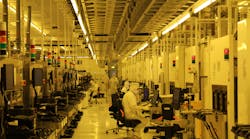Over the last two years, American officials have grown wary of the Chinese government’s plot to boost the country’s chip industry. But executive and government advisors from inside China have also moved to contextualize the efforts.
The hand wringing centers upon the $150 billion fund – also called the Big Fund – that China has amassed to subsidize fabs, fuel acquisitions, and support other tactics that foreign officials say are reminiscent of China’s meddling in the steel and solar markets.
The fund’s existence has drawn harsh rebukes from both the Obama and Trump administrations, which have pushed back against China’s plot to become a semiconductor superpower by 2020. On the other hand, Chinese insiders contend that their concerns are misplaced and overblown.
Shaogun Wei, a professor at Tsinghua University, aimed to tamp down worries with China Semiconductor Industry Association statistics. In addition to the status of fabs and industry growth, he also shared China’s largest fabless chipmakers at the Design Automation Conference in June. (The list of the top ten fabless firms is below).
That perspective acts like a counterweight to the Trump administration, which is probing China’s trade practices. On Monday, the president ordered the United States Trade Representative, Robert Lighthizer, to look into instances of China stealing U.S. intellectual property, which is stock-in-trade for chipmakers.
The order targets intellectual property foul play in multiple industries. But it specifically called out a tactic that chipmakers like Intel and Qualcomm have effectively been forced to go along with. In recent years, they have transferred technology into new companies formed with Chinese partners, as a way of doing business in the country.
A report published by the Obama administration last year denounced China for only punching tickets to companies that fork over chip technology. The report, written by former semiconductor executives, said that China’s tactics could cut into the research budgets of American firms and erode their competitiveness.
At the time, industry lobbyists smiled on the conclusions in the report. And now, they also support President Trump’s trade moves. “Intellectual property is the lifeblood of the semiconductor industry,” said John Neuffer, president of the SIA, in a statement on Monday.
In China, there is growing competition for semiconductor smarts. The number of fabless chipmakers in China rose from 500 to 1,300 over the last five years, and they generated revenues of $24.1 billion in 2016. Below is the list of the the country's largest fabless suppliers last year along with their 2016 revenues.
HiSilicon Semiconductors - $3.87 billion (¥26 billion)
The largest Chinese chip supplier is this subsidiary of Huawei, the smartphone giant and the world’s largest maker of telecommunications gear. Based in the Chinese city of Shenzhen, it sells silicon for surveillance cameras, displays, set-top boxes, and wireless modems.
Tsinghua Unigroup - $1.86 billion (¥12.5 billion)
Tsinghua is something of a microcosm of China’s plans to boost its domestic semiconductor output. In 2013, it bought Spreadtrum Communications and RDA Microelectronics, two of China’s largest mobile chip firms, which have technology transfer deals with Intel. It also plans to invest $30 million in a memory chip factory in Nanjing.
Tsinghua’s chairman Zhao Weiguo has pledged to invest $47 billion in the next three years to become the world’s third largest chipmaker behind Intel and Samsung. But other industry executives are not convinced that Tsinghua, which is backed by the government, can fill that role.
Omnivision - $1.39 billion (¥9 billion)
In 2015, Omnivision Technologies, which designs image sensors for smartphones and tablet cameras, sold itself to Chinese investors for around $1.9 billion. The company, founded in Santa Clara, Calif., makes most of its revenue from China, which boasts the largest smartphone market in the world.
ZTE Microelectronics - $892.57 million (¥6 billion)
The chip designer, based in Shenzhen, operates as a subsidiary of telecommunications giant ZTE, which stole headlines last year for running afoul of U.S. export sanctions. It incurred a $1.9 billion fine from the Commerce Department after selling telecommunications gear with American parts to Iran.
CEC Huada Semiconductor - $505.79 million (¥3.4 billion)
Huada primarily sells security chips for government access cards and SIM cards that telecommunications companies slip into cellphones. In 2009, it became a subsidiary of China Electronics Corporation Holdings, which is directly run by the central government.
Nari Smart Chip - $478.27 million (¥3.2 billion)
Beijing Nari Zhixin Microelectronics Technology is similarly linked to the government through a cascade of subsidies. It sells security and communications chips for smart meters, industrial control systems, and railroad equipment.
It supplies parts to its parent company, which in turn provides electric power equipment to its parent, State Grid Corporation of China, the country’s electric utility monopoly. Unsurprisingly, State Grid is owned by the state.
Shenzen FocalTech - $446.28 million (¥3 billion)
This is the Shenzhen subsidiary of FocalTech Systems, which was founded in California before merging with Taiwan’s Orise Technology in 2015. It makes controllers that measure pressure put onto touch screens, LCD drivers, and fingerprint sensors used in various electronic devices.
Silan Microelectronics - around $342.15 million (¥2.3 billion)
Silan Microelectronics, based in the city of Hangzhou, sells everything from microcontrollers to power management chips. Last year, the company announced that it would invest $120 million in a manufacturing plant with assistance from the Big Fund.
Beijing ISSI - around $342.15 million (¥2.3 billion)
Integrated Silicon Solution Incorporated sells SRAM, DRAM, and flash memory chips. In 2015, the Chinese investment firm, Uphill Investment, bought the fabless chipmaker founded almost thirty years ago in Milpitas, Calif.
Datang Semiconductor - around $342.15 million (¥2.3 billion)
This supplier is a subsidiary of the telecommunications giant Datang. It is more commonly known as Leadcore Technology, which was independent before being acquired in 2015. In January, it formed a new company with Qualcomm called JLQ Technology to devise wireless chips for smartphones and tablets.

